Katana anatomy - Things you need know to truly understand the sword of Samurai
Introduction
There are many parts of a katana, and it can be confusing for those who are new to this piece of art. It's easy to get lost in all the terminology, for Japanese katana, basically there is a specific name for every detail. so we've put together a guide of the most commonly seen terminologies to help you understand what these words mean. With these knowledge, you will know better how to custom your own katana.
To start, we will divide our anatomy into two parts to help you understand all the components of a katana: the blade and the koshirae (fittings include the handle and saya).
Technically, in Japanese, the meaning of the word "katana" refers only to the blade itself, that's why when you look at photos of katana in museums, you will often see only the blade on display. However, outside of Japan, we often use "katana" to refer to the entire sword, which is a minor inaccuracy but acceptable in this context.
Additionally, there are many types of katana, in Japanese, even Spear (Yari) can be classified as Katana (Nihonto), making the terminology too extensive to cover in a single article. So in this article, we will focus on the famous types: Uchigatana (打刀) and Tachi (太刀), along with their koshirae.
Table of Content:
Blade:
- Kissaki (切先)
- Boshi (帽子)
- Yokote (横手)
- Hasaki/Ha (刃先 /刃)
- Mune (棟)
- Shinogi (鎬 / Shinogi-Ji)
- Monouchi (物打)
- Sori (反)
- Nagasa (長さ)
- Kasane (重)
- Mihaba (身幅)
- Bo-Hi (棒樋)
- Hamon (刃文)
- Munemachi (棟区)
- Nakago (茎)
- Mei (銘)
- Nakago jiri (茎尻)
- Mekugi ana (目釘穴)
- Yasurime (鑢目)
Koshirae:
Tsuka:
- Tsuka (柄)
- Tsuba (鍔)
- Habaki (鎺)
- Seppa (切羽)
- Fuchi (緣)
- Kashira (頭)
- Menuki (目貫)
- Mekugi (目釘)
- Tsuka-Ito (柄巻)
- Samegawa (鮫皮)
Saya:
1- The Katana Blade
Blade
The blade is the main component of a Katana, and it is impossible to have a Katana without a blade, because the word “katana” literally means “one sided blade. In ancient Japan, traditional katana should be made of Tamahagane (玉鋼) , essentially it’s a type of high carbon steel. The making of tamahagane is very costly in terms of labour and time, it’s a luxury to use it nowadays. Most modern katana are made of modern steels like carbon steel, manganese steel, T10 steel etc.
Here is a picture shows the major parts of a katana blade:

Kissaki 切先
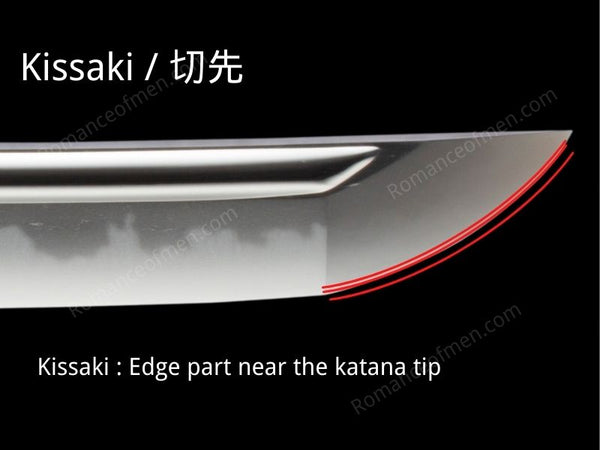
Boshi 帽子
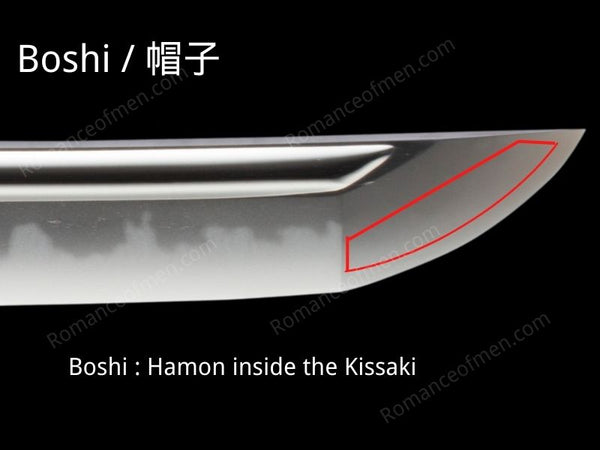
Yokote 横手
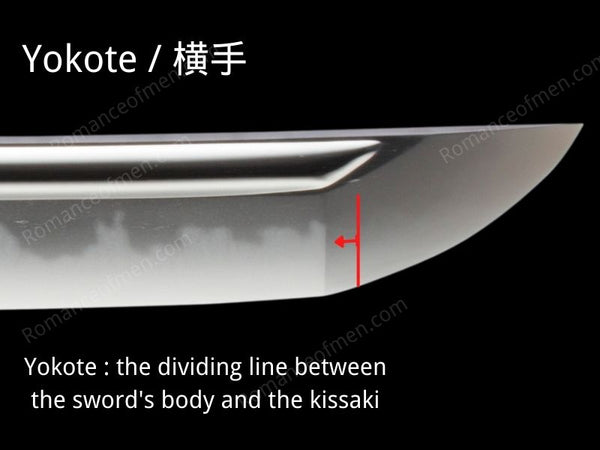
Hasaki / Ha 刃先 /刃
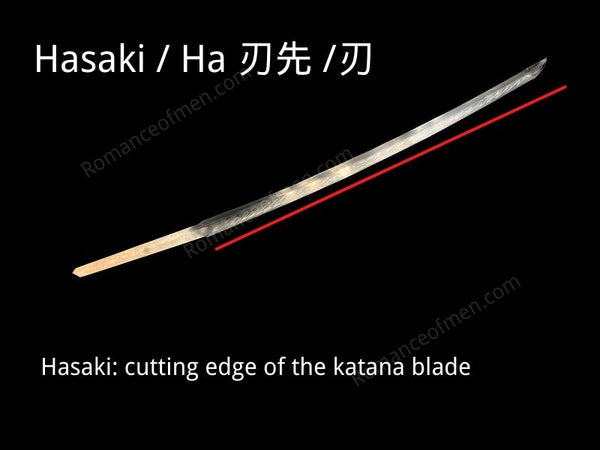
Mune 棟
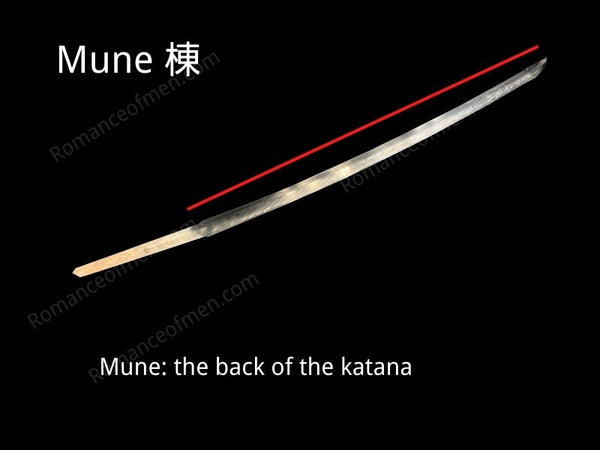
Shinogi 鎬 / Shinogi-Ji
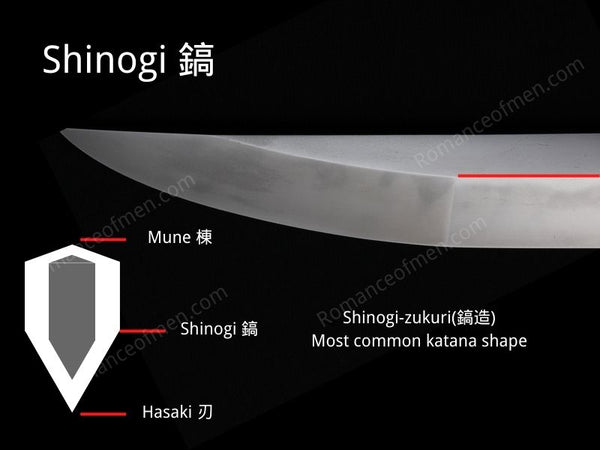
Monouchi (物打)
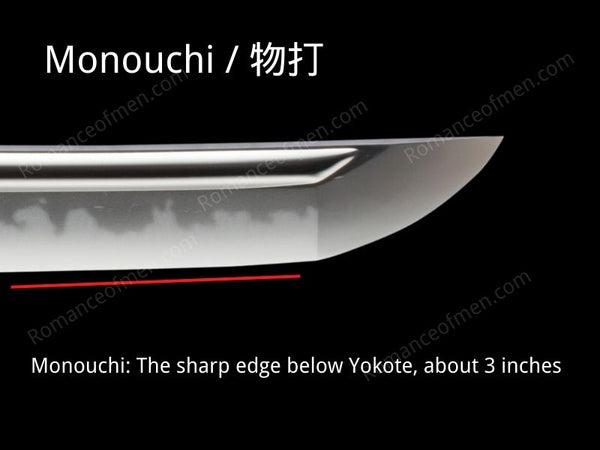
Sori(反)

Nagasa (長さ)
重 (Kasane): The weight of the blade.
身幅 (Mihaba): The width of the blade.

Bo-Hi (棒樋)

Hamon (刃文)

Munemachi (棟区)
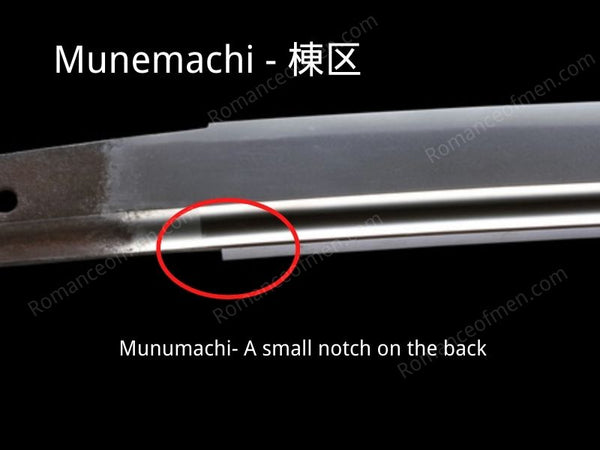
Nakago ( 茎)


銘 (Mei): This is the inscription that swordsmith engraved on the nakago (tang) of the sword.
茎尻 (Nakago jiri): The end of the nakago.
目釘穴 (Mekugi ana): The hole in the tang for the mekugi (peg) that secures the handle to the blade.
鑢目 (Yasurime): File marks on the tang, increase friction to secure the tsuka. Also can be indicative of the swordsmith's style or school.
2-The Katana Koshirae
"Koshirae" (拵) refers to the external mountings of a katana, including the scabbard (saya), hilt (tsuka), and handguard (tsuba). It is a collective term for the decorative parts of a Japanese sword, known as "sword fittings." Koshirae serves three main functions: protecting the katana blade, enhancing its practicality, and showcasing the owner's dignity.
We will also divide the Koshirae into 2 parts : Tsuka and Saya and introduce the related terms:
Tsuka (柄)
The “Tsuka” (handle / hilt) refers to the gripping part of the sword, and the “tang” (nakago) is stored inside. The core of the handle is mostly made of wood, secured with mekugi pins, cover with samegawa, then wrapping with cords. A good tsuka should be tight and secure, no loose parts, and provide comfortable gripping to the user.

Tsuba (鍔)
Tsuba is the hand guard of a katana. the purpose of this component is to protect the hand of the person using the sword from getting cuts on it. It’s also highly valued as an independent art and craft. Tsuba is usually round or square, in iron or copper / brass material.
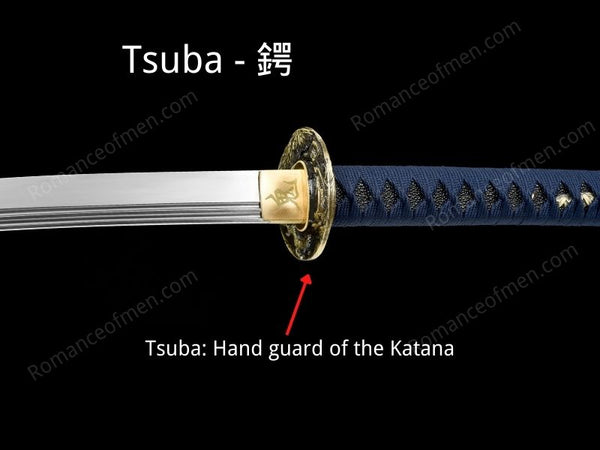
Habaki (鎺)
Habaki (鎺) is the blade collar at the bottom of the blade, not only it holds the blade and scabbard together and tight, but also prevents the scabbard from coming into direct contact with the blade.
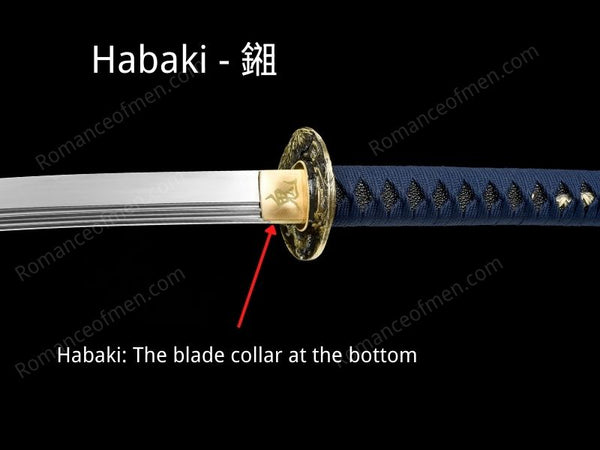
Seppa (切羽)
Seppa are 2 tiny metal plates that you can find on both sides of the Tsuba. The name “切羽” in Japanese means “Cut the feather” These are used as spacers to fill the gaps and secure the tsuba and the blade.
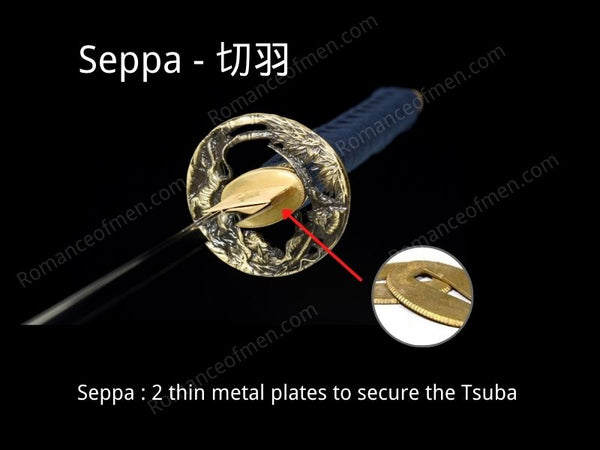
Fuchi (緣) & Kashira (頭)
Fuchi (緣) is the metal collar under Tsuba, Kashira (頭) is the metal cap at the bottom of the Tsuka. They are usually paired, in Japanese they are called “Fuchigashira” (緣頭). Their function is to secure and reinforce the Tsuka.
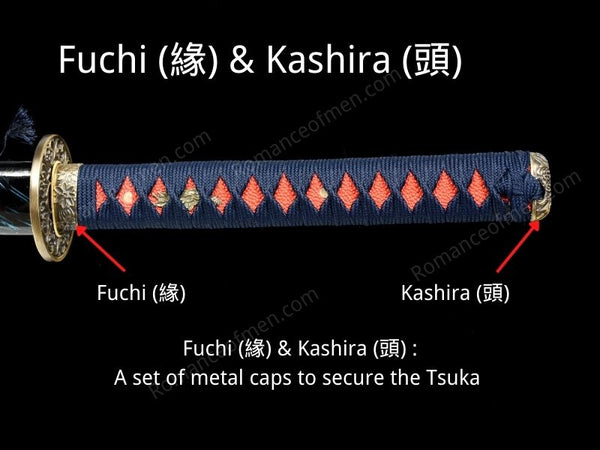
Menuki (目貫)
Menuki are a pair of metal piece under the Ito wrap, one on each side of the Tsuka, basically one for right hand and one for left hand. They are mainly for decoration, usually made of copper or brass, in the shape of different mythological creatures. They do provide better gripping, and helps with hand placement.

Mekugi (目釘)
The pegs that connect handle and the blade, are called Mekugi (目釘). Traditionally they are made of bamboo, some will use brass as well. Mekugi are hammered inside the holes in the tsuka and nakago so they can connect firmly, to dissemble the tsuka you will need to use a tiny hammer to gently push them out as well
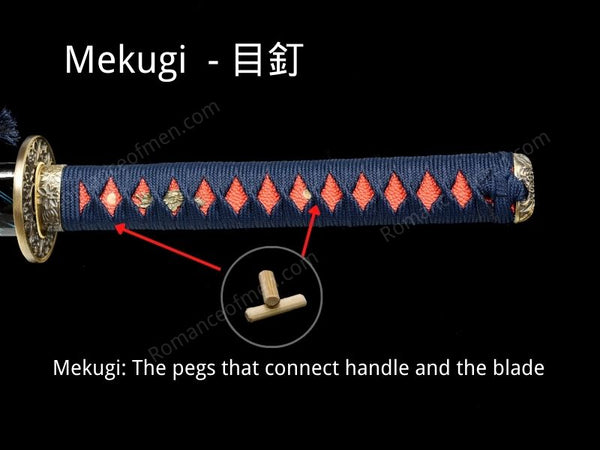
Tsuka-Ito (柄巻)
The wrapping on the Tsuka is called Tsuka-ito (柄巻). Common materials are cotton, silk, leather. Tsuka-ito keeps tsuka and the blade together, and provides better griping for the user, so it has to be tight and secure. There are many types of Tsuka—Ito.
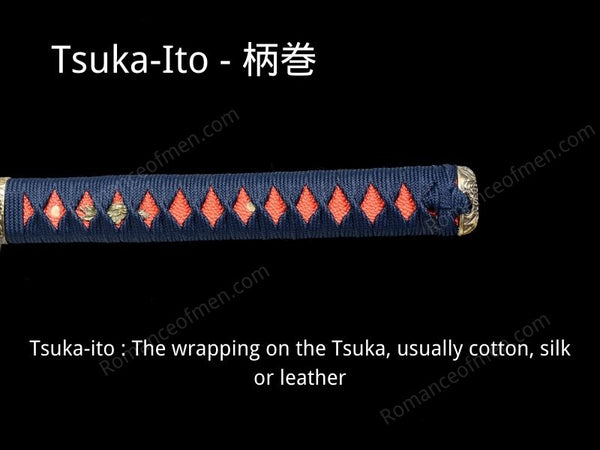
Samegawa (鮫皮)
Underneath the Ito is Samegawa, the name literally means “Shark skin” in Japanese, but actually ray fish skin is commonly used. It is used to cover the wooden plate of Tsuka, and provides better gripping because of the rough texture.
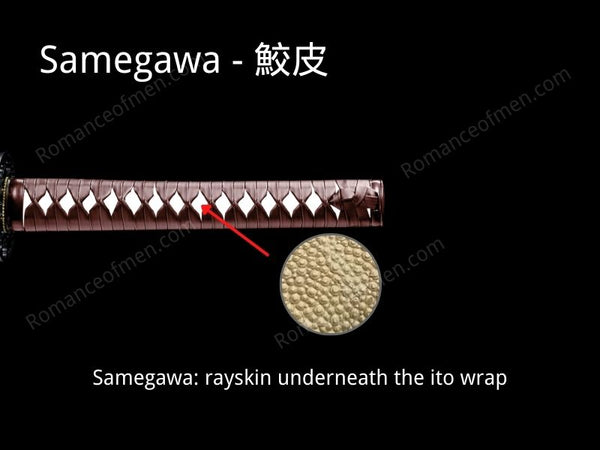
Saya (鞘)
Saya is the part used to protect the steel blade and is also known as the sword's scabbard. Most saya are made of wood, covers with lacquer and beatiful pattern, drawings. Generally speaking there are 2 types of Saya, the ones with many fitting , looking alluring, is for taking the katana out for use. The other type is shirasaya, basically the plain wooden Saya without any decorative elements, used to store the blade for long time.

Koiguchi (鯉口)
The opening of the saya is called Koiguchi, the Japanese name literally means mouth of a carp, It was because its shape resembles it. It should be made perfectly fits the katana, and prevent the blade from constantly cutting against the saya. The outside of Koiguchi is usually cover with another “cap” to further protect the blade, usually in brass or horn material.
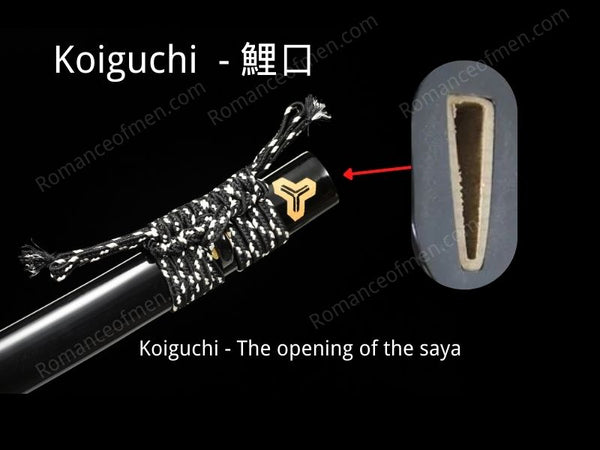
Kurigata (栗形)
The Knob cord retainer on the saya is called “Kurigata”, the name “栗形” in Japanese means “Shape of chestnut”. Inside the Kurigata is a small metal ring called “Shitodome”. Kurigata is used to tie the Sageo.
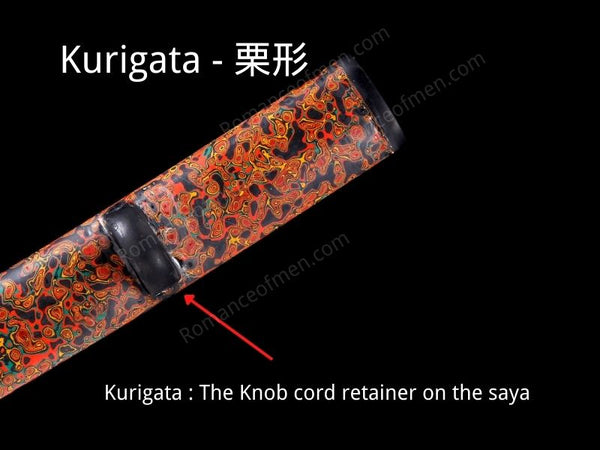
Sageo (下緒)
The cord that connects your katana with your obi (belt) is called Sageo. Sageo is tied on the Kurigata, Sageo is usually made of cotton, and about 180-220 cm long.
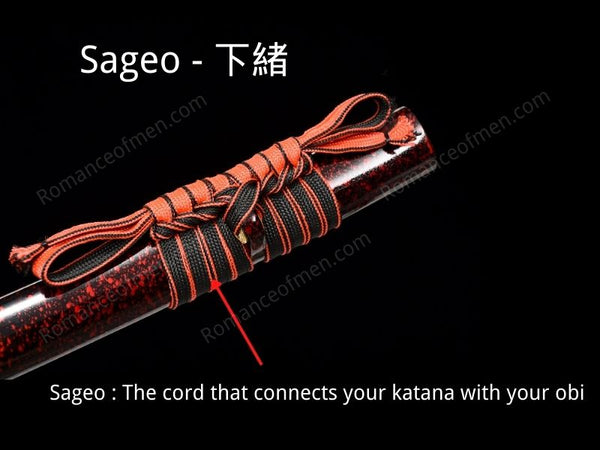
Kojiri (鐺)
The little metal cap at the bottom of the saya is called Kojiri. The purpose is to provide better protection to the saya because this is the Kissaki stored.






















